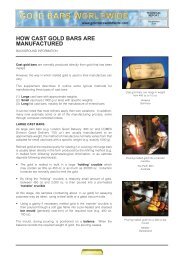Indian Gold Book:Indian Gold Book - Gold Bars Worldwide
Indian Gold Book:Indian Gold Book - Gold Bars Worldwide
Indian Gold Book:Indian Gold Book - Gold Bars Worldwide
You also want an ePaper? Increase the reach of your titles
YUMPU automatically turns print PDFs into web optimized ePapers that Google loves.
GOLD JEWELLERY CONSUMERS<br />
WEDDING JEWELLERY<br />
An agreed amount of jewellery in grammes, or a rupee value, is normally given at the time of marriage,<br />
regardless of the prevailing gold price.<br />
The amount of new jewellery that is purchased can be influenced by several factors.<br />
Arranged marriages<br />
An arranged, as opposed to a “love”, marriage generally involves the gifting of much more jewellery. A common<br />
observation is that more than 90% of rural and 60% of urban marriages are arranged. The number of arranged marriages<br />
is expected to fall. In rural areas, the decline is likely to be gradual.<br />
Dowry<br />
Although the dowry system has been illegal since the early 1960s, the giving of jewellery and other items to the bride, groom<br />
and other family members occurs at every level.<br />
In the case of an arranged marriage, a weight or rupee value of gold jewellery is normally agreed between the families. In<br />
the south, the weight is widely expressed in terms of sovereigns (K22 coins weighing 8 g). For example, 5 sovereigns<br />
(40 g) or less at lower levels, 100 sovereigns (800 g) or more at higher levels.<br />
At higher levels, jewellery as a percentage of the total amount is reported as falling, due to the groom’s and couple’s<br />
preference for lifestyle products. A typical comment is that a percentage in urban areas of around 60% in the mid 1990s<br />
would now range between 25 - 40%. However, as the overall rupee value demanded by many grooms has increased, a<br />
substantial amount of jewellery still tends to be given.<br />
Accumulated jewellery<br />
Many families acquire wedding items over several years in order to meet their obligations at the marriage of their<br />
daughters. Some accumulate items that will eventually be converted into wedding jewellery. Some family jewellery, owned<br />
by the mother or grandmother, may also be converted, or repolished and given.<br />
Economic environment<br />
The conversion of more existing family jewellery may occur if family finances are stretched.<br />
<strong>Gold</strong> price<br />
If the gold price is considered high, more existing family jewellery may also be converted.<br />
Non-Resident <strong>Indian</strong>s (NRI’s)<br />
Millions of <strong>Indian</strong>s working in the Middle East, Europe, USA and elsewhere remit funds to their families. This enables many<br />
poorer families to boost their purchases substantially.<br />
New jewellery is normally bought 2 - 4 weeks prior to the marriage, although it may be chosen well beforehand. Retailers<br />
in both urban and rural areas observe that, as the purchase of bridal jewellery is so important, many families travel to<br />
larger cities and towns. Status is enhanced, and more designs are available.<br />
Purchases can range from a few grammes to several kilos.<br />
The chosen categories, weights and styles of individual items can vary according to regional, community and personal<br />
preferences. An appendix illustrates what might be purchased at the level of 200 g.<br />
Apart from bridal jewellery bought by the bride’s parents, other jewellery can also be bought at this time. The bride can<br />
receive items from the groom’s family, the groom from the bride’s family. Other members of both families can give or receive<br />
gifts of jewellery (or coins).<br />
OTHER GIFTS WITHIN THE FAMILY<br />
The giving of gold jewellery at important family occasions is common among those who can afford to do so.<br />
It may be given at a child’s naming ceremony, puberty, birthdays and anniversaries, and on the occasion of festivals and<br />
some auspicious days.<br />
For example, at a naming ceremony, a small bangle, hip chain, chain, pendant and anklet may be given.<br />
The main recipients are girls and women. Girls need to accumulate jewellery for their marriage. For many married women,<br />
jewellery is their only personal asset.<br />
The “other gift” market is important for most large showrooms, its share ranging from 10 - 15% and more. For most small<br />
urban and rural outlets, the gift market tends to be small.<br />
PERSONAL PURCHASES<br />
Fashion is reported as stimulating more personal purchases in large urban showrooms. Investment<br />
continues to drive many personal purchases in smaller outlets and in rural areas.<br />
Although described as “personal”, retailers observe that most purchases are the outcome of family decisions. Many fall<br />
within the category of gifts when funded by the head of the family.<br />
118<br />
AN INTRODUCTION TO THE INDIAN GOLD MARKET

















